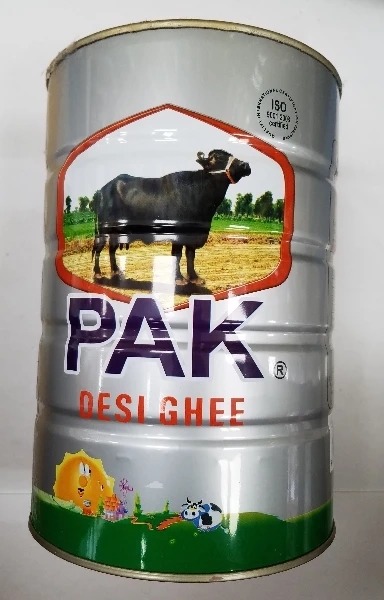Pak Desi Ghee, often referred to simply as "Desi Ghee," is a staple in many South Asian kitchens. Derived from the milk of cows that are predominantly grass-fed, this golden-hued clarified butter is revered not only for its rich, nutty flavor but also for its numerous health benefits. In this comprehensive guide, we delve into the history, production process, nutritional benefits, and culinary uses of Pak Desi Ghee, highlighting why it deserves a place in your pantry.
The History of Pak Desi Ghee
Pak Desi Ghee has a storied past, with its origins tracing back thousands of years to the ancient civilizations of the Indian subcontinent. Historically, it was considered a symbol of purity and was used in religious rituals and traditional medicine, particularly in Ayurveda. The method of making ghee has been passed down through generations, with each family often having its own secret recipe.
The Production Process of Pak Desi Ghee
The production of Pak Desi Ghee is a meticulous process that involves several steps:
- Milk Collection: High-quality, grass-fed cow’s milk is collected and set to rest, allowing the cream to rise to the top.
- Churning: The cream is then churned to separate the butter from the buttermilk.
- Clarification: The butter is heated to remove all water content, resulting in a clear, golden liquid.
- Filtration: The liquid ghee is filtered to remove any remaining milk solids, ensuring a pure product.
This traditional method of preparation not only ensures the ghee retains its rich flavor but also its nutritional integrity.
Nutritional Benefits of Pak Desi Ghee
Pak Desi Ghee is packed with nutrients that offer a range of health benefits:
- Rich in Healthy Fats: Ghee is a source of saturated fats, which are essential for the absorption of fat-soluble vitamins like A, D, E, and K.
- Contains Butyrate: This short-chain fatty acid has anti-inflammatory properties and supports gut health.
- Lactose-Free: The clarification process removes lactose, making it suitable for those with lactose intolerance.
- Boosts Immunity: Traditional Ayurvedic practices suggest that ghee enhances the body’s immune response.
Culinary Uses of Pak Desi Ghee
Pak Desi Ghee\'s high smoke point makes it a versatile cooking fat. Here are some ways to incorporate it into your diet:
- Cooking and Frying: Its high smoke point of around 485°F (252°C) makes it ideal for frying and sautéing without breaking down into harmful compounds.
- Baking: Substitute butter with ghee in baking for a rich, nutty flavor.
- Spreading: Use it as a spread on bread or toast for a deliciously creamy texture.
- Finishing Oil: Drizzle it over cooked dishes, such as rice or vegetables, to enhance flavor and add a luxurious finish.
Pak Desi Ghee in Traditional Medicine
In Ayurvedic medicine, Pak Desi Ghee is considered a potent healer. It is used in various treatments and practices:
- Detoxification: Ghee is believed to aid in the removal of toxins from the body.
- Improved Digestion: It is said to stimulate the digestive system, enhancing the absorption of nutrients.
- Skin Health: Applied topically, ghee can moisturize and heal dry, chapped skin.
- Mental Clarity: Consuming ghee is thought to support cognitive function and clarity.
Choosing and Storing Pak Desi Ghee
When selecting Pak Desi Ghee, quality is paramount. Here are some tips:
- Source: Opt for ghee made from grass-fed cows for the highest nutrient content.
- Purity: Ensure the ghee is free from additives and preservatives.
- Packaging: Choose ghee packaged in glass jars to avoid chemical leaching from plastic containers.
For storage, keep your Pak Desi Ghee in a cool, dark place. It doesn’t need refrigeration and can last for months due to its low moisture content.
Incorporating Pak Desi Ghee into Your Diet
Integrating Pak Desi Ghee into your daily diet can be both easy and enjoyable. Here are some recipe ideas:
Golden Turmeric Latte
A soothing drink that combines the benefits of ghee with the anti-inflammatory properties of turmeric.
Ingredients:
- 1 cup milk (or plant-based alternative)
- 1 teaspoon Pak Desi Ghee
- 1 teaspoon turmeric powder
- 1/2 teaspoon cinnamon
- 1/2 teaspoon ginger powder
- Honey or maple syrup to taste
Instructions:
- Heat the milk in a saucepan over medium heat.
- Add the ghee, turmeric, cinnamon, and ginger.
- Stir until well combined and heated through.
- Sweeten with honey or maple syrup and enjoy warm.
Ghee-Roasted Vegetables
A simple yet delicious way to elevate your vegetable dishes.
Ingredients:
- Assorted vegetables (carrots, potatoes, bell peppers, etc.)
- 2 tablespoons Pak Desi Ghee
- Salt and pepper to taste
- Fresh herbs (optional)
Instructions:
- Preheat your oven to 400°F (200°C).
- Toss the vegetables with Pak Desi Ghee, salt, and pepper.
- Spread them out on a baking sheet.
- Roast for 20-25 minutes, or until tender and golden.
- Sprinkle with fresh herbs if desired and serve hot.
Conclusion
Embrace the Tradition of Pak Desi Ghee
Pak Desi Ghee is more than just a cooking fat; it is a superfood with a rich history and a plethora of health benefits. By incorporating this traditional ingredient into your diet, you can enjoy its delightful flavor while reaping its nutritional rewards. Whether you\'re using it in cooking, baking, or as a finishing touch to your dishes, Pak Desi Ghee can elevate your culinary creations and contribute to a healthier lifestyle.
Embrace the tradition, and make Pak Desi Ghee a staple in your kitchen. Your taste buds and your body will thank you.


